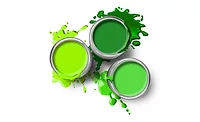Axalta and MIT Pioneer Technologies to Analyze Waterborne Paint Sprayability
GLEN MILLS, PA - Eric Houze, Research Fellow at Axalta Coating Systems, and Bavand Keshavarz, a Ph.D. candidate from the Massachusetts Institute of Technology (MIT), presented the results of a joint research program on new rheological measurement technologies that can be applied to sprayable paints. The two presentations were delivered on October 7 and 8, respectively, at the Society of Rheology’s 86th annual meeting in Philadelphia, which is attended by global rheology experts who study the deformation and flow of materials, including paints.
The Axalta and MIT team developed a new technology to analyze and quantify the behavior of complex fluids during spray applications. During the paint spray application process, droplet particle sizes and distributions can be determining factors for the quality and appearance of the final paint. The new technology is designed to help improve paint sprayability during the application process, which should result in an improvement in the surface quality and visual appeal.
“Historically, industry researchers used high shear viscosity (HSV) or Capillary Breakup Extensional Rheometer (CBER) to assess capillary thinning and the filament formation dynamics of paint. This can often be related to the droplet formation process during paint spray application, but can be limited as a result of relatively low relaxation times observed in commercial paints,” explained Houze. “Together, with my Axalta colleagues Mike Koerner, John Moore and the MIT team, we developed a jet-based rheometry approach to analyze a sample’s behavior at very high-strain rates that can determine relaxation times of waterborne paints down to about 60 microseconds. This technique is known as Rayleigh-Ohnesorge Jetting Rheometry (ROJER).”
“Air-assisted atomization in spraying of complex liquids is a key process in many industrial applications, but the effects of some rheological properties on the process are still poorly understood,” said Dr. Gareth McKinley, MIT School of Engineering Professor of Teaching Innovation and Associate Head for Research. “The new technologies that we developed together with Axalta can connect the rheological fingerprints of a material to industrial applications, such as sprayability of paints.”
“At Axalta, it is important for us to work with top academic institutions like MIT to continue to explore the science of coatings,” said Panos Kordomenos, Axalta’s Senior Vice President and Chief Technology Officer. “This collaborative research integrates expertise, coating applications and rheology that will help us continue to make advances."
Looking for a reprint of this article?
From high-res PDFs to custom plaques, order your copy today!





